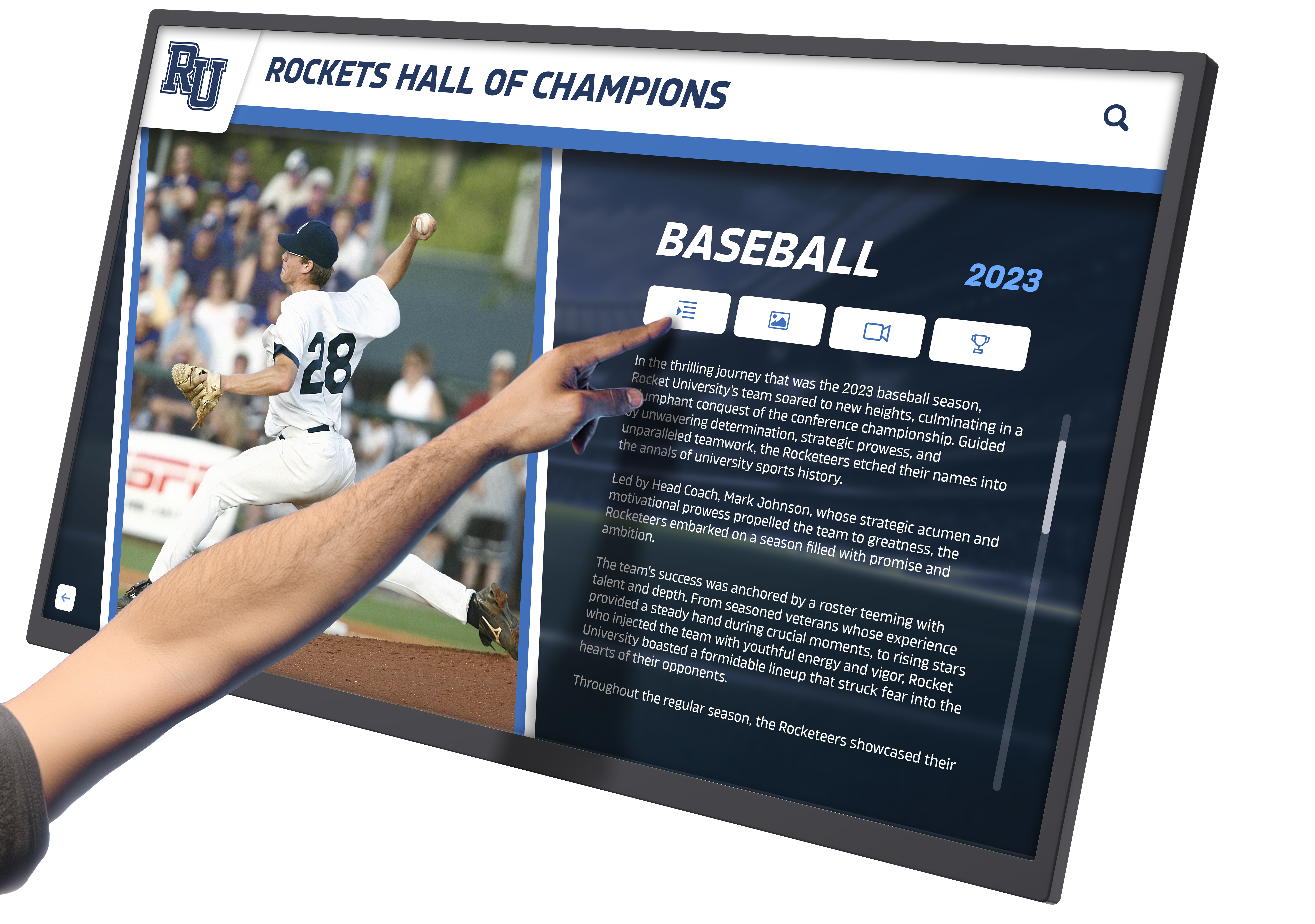Display technology serves as the foundation of modern digital halls of fame, transforming how organizations recognize achievement, preserve history, and engage visitors with interactive storytelling. Among commercial display manufacturers, ViewSonic has established itself as a prominent provider of touchscreen displays and interactive panels used across educational institutions, corporate environments, and recognition applications worldwide.
When planning digital recognition programs—whether honoring athletic achievements, celebrating alumni accomplishments, recognizing employee contributions, or preserving organizational heritage—selecting appropriate display technology directly impacts user experience, program longevity, and overall effectiveness. The display becomes the interface through which visitors discover stories, explore achievements, and connect with recognized individuals, making hardware selection one of the most consequential decisions in digital recognition program implementation.
This comprehensive guide explores ViewSonic displays in the context of digital hall of fame applications, examining hardware specifications relevant to recognition programs, interactive capabilities supporting engagement, display selection criteria for different installation environments, and integration considerations for comprehensive recognition systems. Whether implementing your first digital recognition program or upgrading existing installations, understanding display technology ensures selections that serve your recognition objectives effectively for years to come.
Understanding ViewSonic Display Technology: Company Background and Product Lines
ViewSonic Corporation, founded in 1987 and headquartered in Brea, California, manufactures visual display products spanning computer monitors, projectors, interactive flat panels, digital signage displays, and LED display solutions. The company’s product portfolio serves diverse markets including education, corporate environments, healthcare, retail, and public spaces requiring display technology.
ViewSonic Interactive Display Product Categories
ViewSonic organizes its interactive display offerings into several distinct product families, each designed for specific applications and use cases.
ViewBoard Interactive Flat Panels: ViewSonic’s ViewBoard line represents the company’s primary interactive display platform designed for educational and corporate collaboration applications. These large-format touchscreen displays typically range from 55" to 98" diagonal sizes, featuring multi-touch capabilities supporting simultaneous touch points from multiple users, integrated computing modules eliminating external computer requirements, wireless screen sharing supporting bring-your-own-device connectivity, and built-in whiteboarding and annotation software.
ViewBoard displays incorporate infrared touch technology detecting touch through IR sensor grids, providing responsive interaction without requiring special styluses or physical pressure. This technology works reliably across various lighting conditions and supports both finger touch and stylus input.
Commercial Display Panels: Beyond interactive models, ViewSonic manufactures commercial-grade non-touch displays suitable for digital signage and information display applications. These panels feature higher brightness specifications than consumer televisions (typically 400-700 nits), extended operational ratings supporting 16-24 hour daily use, commercial-grade panels with longer lifespans, and landscape and portrait orientation capabilities.
For hall of fame applications requiring content display without interactive navigation, commercial panels paired with external touch overlays or used as pure digital signage represent cost-effective alternatives to fully integrated interactive displays.
Outdoor and Semi-Outdoor Displays: ViewSonic also offers specialized displays engineered for outdoor or semi-outdoor environments, featuring significantly enhanced brightness (1,500-3,000+ nits), weatherproofing and thermal management, anti-glare treatments for sunlight readability, and ruggedized enclosures protecting against environmental factors.
These specialized displays serve outdoor memorial applications or recognition installations in environments with significant natural light exposure.

ViewSonic Display Specifications Relevant to Recognition Applications
Understanding key display specifications helps organizations evaluate whether ViewSonic or alternative display technologies suit specific recognition program requirements.
Display Resolution and Size: Modern commercial interactive displays typically offer 4K Ultra HD resolution (3840x2160 pixels) across larger display sizes, with Full HD (1920x1080) resolution available in smaller formats. For hall of fame applications displaying biographical content, photographs, videos, and interactive navigation, 4K resolution provides superior image clarity, particularly on displays exceeding 65" diagonal where Full HD may appear less sharp.
Display size selection depends on installation space, viewing distance, and content complexity. Choosing appropriate screen sizes requires balancing visibility from typical viewing distances with physical space constraints and budget considerations.
Touch Technology and Responsiveness: Touch technology fundamentally impacts user experience with interactive recognition displays. ViewSonic’s ViewBoard line utilizes infrared touch technology offering several advantages including no-pressure touch requiring minimal force, support for multiple simultaneous touch points, compatibility with fingers, styluses, or any opaque object, and no degradation of image quality from touch overlays.
Touch responsiveness—measured in milliseconds between touch detection and system response—significantly affects user experience. Commercial interactive displays should deliver sub-50ms touch latency ensuring interactions feel immediate rather than sluggish.
Brightness and Viewing Angles: Display brightness, measured in nits (candelas per square meter), determines visibility in various lighting conditions. Consumer televisions typically deliver 250-350 nits appropriate for controlled residential lighting. Commercial displays require higher brightness for public spaces with ambient lighting, window exposure, or overhead illumination.
For indoor hall of fame installations in typical building lighting, 400-500 nits provides adequate brightness. High-ambient-light environments like lobbies with significant natural light benefit from 600-700+ nit displays ensuring content remains clearly visible.
Viewing angles specify how far off-center viewers can position themselves while maintaining acceptable image quality. Wide viewing angles (178° horizontal and vertical) ensure multiple visitors can view displays simultaneously from various positions without significant brightness or color degradation.
Durability and Commercial Ratings: Consumer televisions assume residential operation patterns—perhaps 4-8 hours daily use in temperature-controlled environments. Commercial displays engineered for institutional deployment feature significantly enhanced durability including 16-24 hour operational ratings supporting continuous operation, extended warranties (3-5 years versus 1-year consumer warranties), ruggedized components tolerating public environment demands, and thermal management supporting reliable operation in higher-temperature environments.
Commercial-grade equipment proves essential for recognition applications where displays may operate 12-16 hours daily, every day of the year, accumulating operational hours that would quickly exceed consumer equipment design parameters.

Display Hardware Selection for Hall of Fame Applications: Key Considerations
Selecting appropriate display technology for digital recognition requires evaluating multiple factors beyond brand reputation, ensuring chosen hardware aligns with specific program requirements and installation contexts.
Installation Environment Assessment
Physical installation environments significantly influence display requirements and optimal specifications.
Indoor Controlled Lighting: Recognition displays in areas with controlled lighting—interior hallways, dedicated memorial spaces, or rooms without significant natural light—permit displays with standard commercial brightness (400-500 nits). These environments allow focus on other display attributes like size, resolution, and interactive capabilities without requiring specialized high-brightness specifications.
Standard commercial displays deliver excellent performance in these conditions while maintaining more accessible price points than specialized high-brightness models.
High-Ambient-Light Environments: Spaces with substantial windows, skylights, or floor-to-ceiling glass require enhanced display brightness ensuring content remains clearly visible. Lobbies, atriums, or outdoor-adjacent spaces may experience direct or indirect sunlight creating bright ambient conditions that wash out standard displays.
For these challenging lighting environments, specify displays delivering 600-700+ nits brightness. Some applications may benefit from anti-glare or anti-reflective screen treatments reducing reflection from overhead lighting or windows.
Temperature and Environmental Factors: Consider temperature ranges and environmental conditions in installation locations. While most indoor spaces maintain comfortable temperature ranges, some installations—entrance vestibules, unheated historical buildings, or semi-outdoor covered spaces—may experience temperature extremes.
Standard commercial displays typically specify operating temperature ranges of 32°F to 104°F (0°C to 40°C). Environments regularly exceeding these ranges require specialized displays with expanded temperature ratings or environmental control systems maintaining suitable conditions.
Physical Security and Vandalism Resistance: Public-facing recognition installations in unsupervised areas benefit from vandalism-resistant features including tempered glass or acrylic protective layers shielding display surfaces, tamper-resistant mounting hardware preventing theft or displacement, lockable cabinets securing display edges and connections, and optional sensor-based monitoring detecting tampering attempts.
Educational institutions, municipal installations, and other public spaces should evaluate vandalism risk and implement appropriate protective measures during initial installation rather than addressing damage after incidents occur.
Interactive Capabilities and Touch Technology
Different recognition program designs require varying levels of interactive capability influencing display selection.
Multi-Touch Interactive Displays: Full interactive recognition programs enabling visitors to browse profiles, search databases, watch videos, and explore content require responsive multi-touch displays supporting intuitive navigation gestures including tap for selection, swipe for scrolling, pinch-to-zoom for image viewing, and multi-finger gestures for specialized functions.
ViewSonic’s ViewBoard series and similar interactive flat panels from various manufacturers deliver these capabilities through infrared, capacitive, or optical touch technologies. For interactive hall of fame applications, these fully interactive displays provide optimal user experiences.
Single-Touch Simplified Interaction: Some recognition programs implement simplified interfaces requiring only basic touch interaction—tapping to select options or advancing through sequential content. These simpler interaction models may function adequately with single-touch displays offering lower cost than multi-touch alternatives while supporting essential navigation.
However, modern user expectations shaped by smartphones and tablets generally favor multi-touch capabilities delivering more intuitive, familiar interaction patterns.
Non-Touch Digital Signage: Certain recognition applications require only content display without visitor interaction—automated slideshow presentations cycling through recognized individuals, static digital displays replacing traditional plaques, or supplemental displays accompanying primary interactive installations.
These applications benefit from commercial digital signage displays without touch capabilities, offering cost savings compared to interactive models while providing commercial-grade reliability and appropriate brightness.
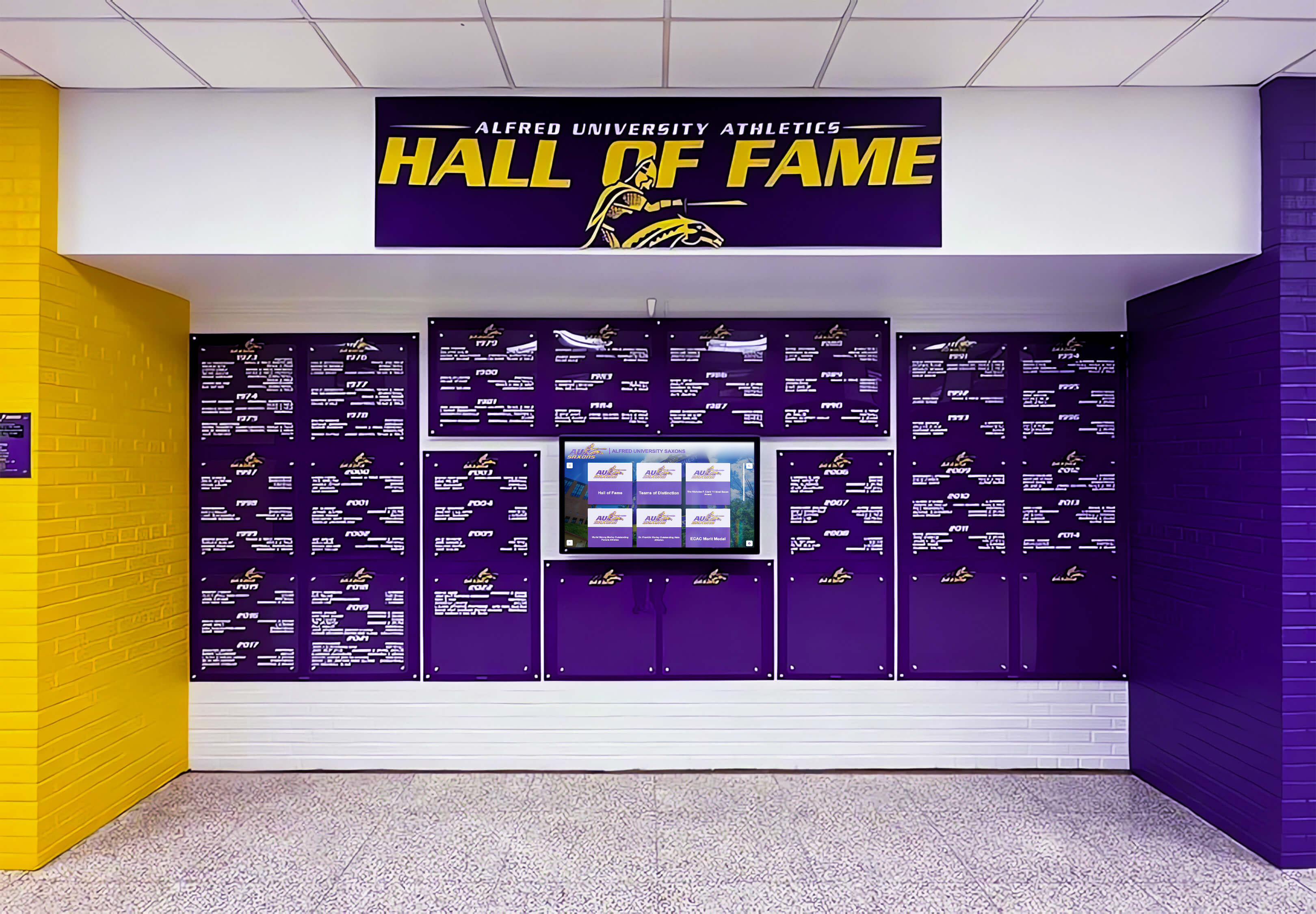
Display Connectivity and Integration
Modern hall of fame systems require displays to integrate with various computing platforms, content management systems, and network infrastructure.
Computing Integration: Interactive recognition displays require computing platforms running recognition software and managing content databases. Integration approaches include integrated computing modules built into displays eliminating external computers, external dedicated computers (mini PCs, NUCs, or small form-factor systems) connected via HDMI/DisplayPort, networked computing where displays connect to servers running recognition applications, and cloud-based platforms where displays function as thin clients connecting to cloud-hosted recognition systems.
ViewSonic ViewBoard displays offer optional integrated computing modules (OPS - Open Pluggable Specification) allowing compact computers to mount directly inside displays, creating clean installations without visible external equipment.
Network Connectivity: Modern recognition systems require network connectivity for content updates, remote management, and cloud platform integration. Displays should provide Ethernet connectivity for reliable wired networking, and Wi-Fi connectivity for installations where wired connections prove impractical.
Wired Ethernet generally delivers superior reliability for permanent installations, avoiding potential wireless interference or connectivity issues that could impact system availability.
Content Management Integration: Recognition displays must integrate with content management platforms controlling displayed content. Touchscreen software solutions designed specifically for recognition applications provide intuitive interfaces for managing profiles, updating information, and organizing content without requiring technical expertise.
Ensure chosen displays support your selected content management platform’s technical requirements including supported operating systems, resolution requirements, and hardware specifications.
Remote Management Capabilities: Enterprise display management enables IT administrators to monitor display health, adjust settings, troubleshoot issues, and update software remotely without physically accessing installations. Many commercial displays provide integrated management platforms or support third-party management systems.
For organizations managing multiple recognition displays across campuses or distributed locations, remote management capabilities dramatically reduce ongoing support overhead.
ViewSonic Displays in Recognition Applications: Practical Implementation
Understanding how ViewSonic displays integrate into complete digital hall of fame systems helps organizations plan successful implementations.
Complete System Architecture
Digital recognition programs involve multiple integrated components working together to deliver compelling visitor experiences.
Hardware Components: Complete recognition systems typically include interactive touchscreen display (ViewSonic or alternative commercial display), computing platform running recognition software, mounting system or kiosk enclosure, network connectivity equipment, power supply and conditioning, and optional components like speakers, cameras, or NFC readers.
The display represents the most visible component but functions as part of a comprehensive system where all elements must work together reliably.
Software Platforms: Recognition displays require specialized software managing content, user interface, and visitor interaction. Organizations can choose from several approaches including purpose-built recognition platforms designed specifically for halls of fame, digital signage content management systems adapted for recognition use, custom-developed applications tailored to unique requirements, and web-based platforms accessed through display browsers.
Solutions like Rocket Alumni Solutions provide specialized software platforms designed specifically for recognition applications, offering intuitive interfaces for managing profiles, organizing content, and creating engaging visitor experiences optimized for touchscreen interaction.
Content Development: Compelling recognition programs require substantial content development including biographical profiles, photograph digitization and enhancement, video editing and production, graphic design and layout, and database organization and structuring.
Content quality ultimately determines program effectiveness regardless of display technology quality. Invest adequate resources in comprehensive content development ensuring displays showcase meaningful stories rather than sparse information.
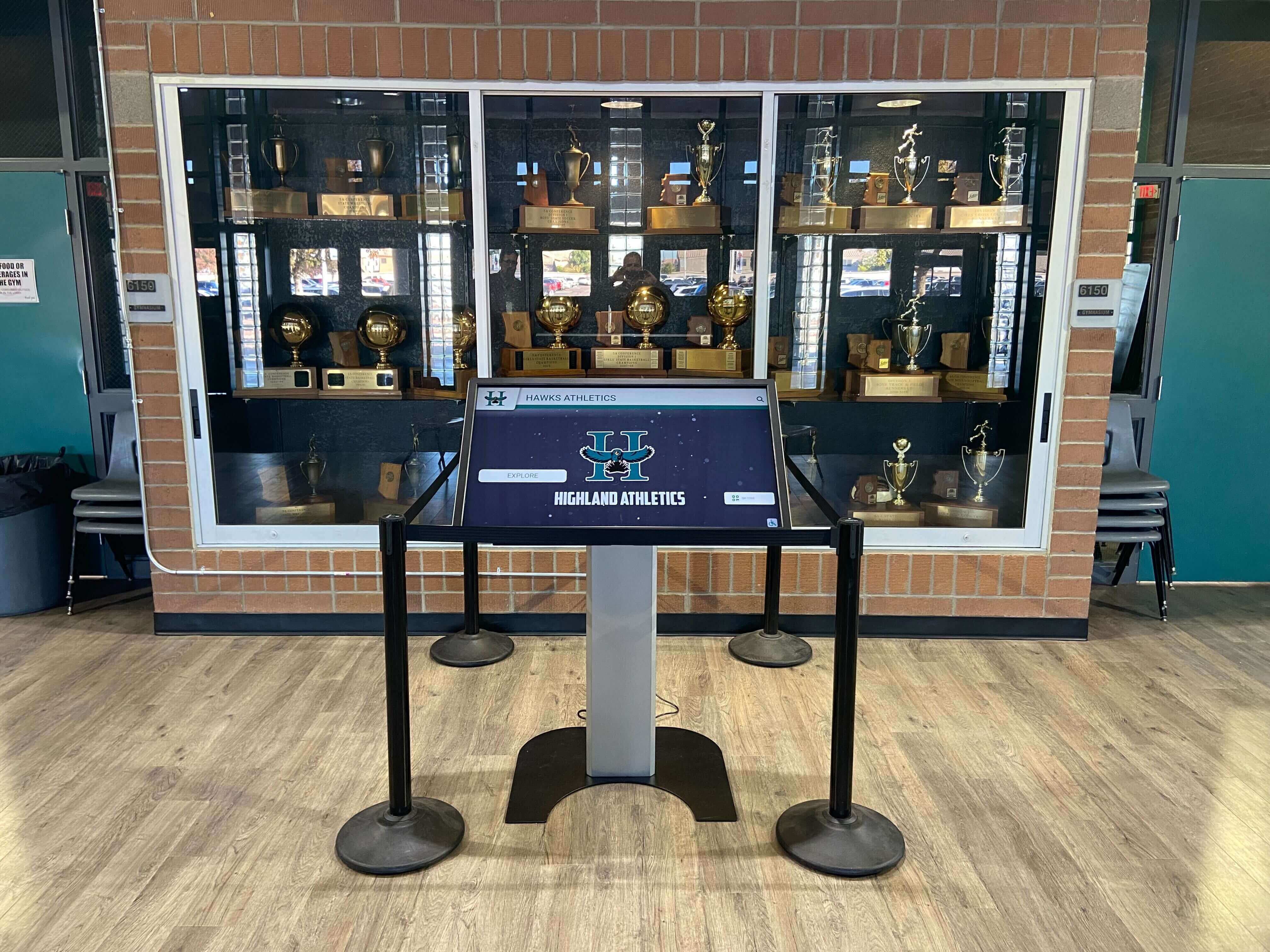
Installation and Deployment Best Practices
Professional installation ensures displays function reliably and present polished appearances appropriate for recognition applications.
Physical Mounting and Positioning: Display mounting significantly impacts visibility, accessibility, and aesthetics. Consider mounting height positioning displays at comfortable viewing heights for diverse users, viewing angle orientation perpendicular to primary viewing positions, clearance ensuring adequate space for visitor approach and interaction, and security fasteners preventing theft or tampering in public spaces.
Wall-mounted installations offer clean, permanent solutions for controlled environments. Freestanding kiosks provide flexibility for spaces where wall mounting proves impractical or where displays may require repositioning.
Infrastructure Requirements: Plan installation infrastructure thoroughly including electrical service providing adequate power for displays and computing equipment, network connectivity for content management and updates, physical security if required by installation environment, environmental controls maintaining appropriate temperature and humidity, and accessibility compliance meeting ADA and universal design standards.
Engage facilities management and IT departments early in planning processes, ensuring infrastructure support receives adequate attention before installation dates.
Professional Installation Services: While organizations with technical capabilities may consider self-installation, professional installation services offer significant advantages including expertise with commercial display mounting, proper cable management and finishing, system integration and configuration, testing and quality assurance, and warranty compliance ensuring manufacturer coverage remains valid.
Many recognition technology providers, including Rocket Alumni Solutions, offer turnkey installation services handling all aspects from infrastructure coordination through final testing and training.
Ongoing Operation and Maintenance
Reliable recognition program operation requires ongoing attention ensuring displays function properly and content remains current.
Routine Maintenance: Commercial displays require minimal but important routine maintenance including display cleaning using appropriate products, touch calibration if accuracy degrades, software updates for computing platforms and recognition applications, hardware monitoring checking for operational issues, and content updates adding new recognitions and refreshing existing information.
Establish maintenance schedules assigning responsibility for routine tasks, preventing neglect that could impact system reliability or user experience.
Technical Support and Troubleshooting: Even high-quality commercial equipment occasionally experiences issues requiring troubleshooting. Maintain comprehensive support documentation including manufacturer contact information and warranty details, software vendor support channels, installer contact information for warranty service, IT department escalation procedures, and troubleshooting guides for common issues.
Many recognition platform providers offer ongoing technical support ensuring organizations receive prompt assistance when issues arise, minimizing downtime and maintaining program effectiveness.
Content Management and Updates: Recognition programs require ongoing content management as organizations identify new recognitions, update existing profiles, and maintain information accuracy. Select content management platforms enabling non-technical administrators to perform routine updates without requiring IT support for every change.
Cloud-based recognition platforms offer particular advantages for content management, allowing updates from any location without requiring direct access to display installations.

Beyond ViewSonic: Alternative Display Technologies for Recognition Applications
While ViewSonic offers commercial displays suitable for recognition applications, organizations should evaluate multiple manufacturers ensuring optimal solutions for specific requirements and budgets.
Comparative Display Technologies
Multiple commercial display manufacturers serve recognition and digital signage markets, each offering distinct capabilities, specifications, and value propositions.
Samsung Commercial Displays: Samsung’s extensive commercial display portfolio includes interactive and non-touch models across diverse size ranges. Samsung displays generally feature high brightness specifications, integrated commercial-grade panels, Tizen operating system supporting standalone operation, and comprehensive enterprise management platforms.
Samsung’s market position delivers wide availability, extensive dealer networks, and competitive pricing across multiple product tiers.
LG Commercial Displays: LG manufactures commercial displays and interactive touchscreens widely deployed in educational and corporate environments. LG displays offer WebOS operating system enabling browser-based applications, high-brightness specifications for challenging lighting, ultra-narrow bezels supporting video wall configurations, and extensive warranty and support programs.
Promethean Interactive Displays: Promethean specializes in educational technology including interactive displays and accompanying software specifically designed for teaching and learning applications. While primarily education-focused, Promethean’s experience with interactive engagement translates to recognition applications requiring visitor interaction.
SMART Interactive Displays: SMART Technologies pioneered interactive whiteboards and continues manufacturing interactive displays for education and corporate collaboration. SMART displays emphasize intuitive interaction, collaborative features, and specialized software supporting engagement.
Display Selection Decision Framework
Choosing optimal display technology requires systematic evaluation balancing multiple factors.
Requirements Assessment: Define specific recognition program requirements including display size needs based on viewing distance and space, interactive versus display-only requirements, brightness requirements for installation lighting, budget constraints for hardware acquisition, mounting approach (wall mount, kiosk, etc.), and integration requirements with content management systems.
Clear requirements enable objective evaluation of alternative display technologies ensuring selections align with actual program needs rather than defaulting to familiar brands without comparative analysis.
Comparative Evaluation: Evaluate multiple display options systematically comparing specifications against requirements, testing touch responsiveness and user experience, assessing warranty terms and support availability, reviewing total cost of ownership including acquisition and ongoing operation, and examining integration compatibility with chosen recognition software platforms.
Request demonstration units or arrange site visits to similar installations allowing hands-on evaluation before committing to specific display technologies.
Vendor and Support Considerations: Display technology represents long-term investments requiring ongoing support and service. Evaluate manufacturer support quality, local dealer availability and reputation, warranty terms and service response times, availability of replacement parts and service, and long-term manufacturer viability ensuring support continuity.
Working with experienced recognition technology providers offering comprehensive solutions including display hardware, software platforms, installation services, and ongoing support simplifies procurement while ensuring all components work together reliably.
Advanced Display Features for Enhanced Recognition Experiences
Modern commercial displays offer advanced capabilities that can enhance recognition program effectiveness and visitor engagement.
Ultra-High-Definition and Large-Format Displays
Display size and resolution significantly impact content presentation quality and visitor experience.
4K and 8K Resolution: While Full HD (1920x1080) resolution proved adequate for earlier digital signage, modern expectations favor 4K Ultra HD (3840x2160) for displays exceeding 55" diagonal. The quadrupled pixel count delivers notably sharper images, text, and photographs particularly visible at close viewing distances typical of interactive recognition displays.
Some premium commercial displays now offer 8K resolution (7680x4320), though practical benefits remain limited for most recognition applications given content production complexity and computing requirements for 8K video playback.
Large-Format Displays (75"-98"+): Recognition installations in large spaces—campus centers, corporate lobbies, or museum-style environments—may benefit from displays exceeding standard 55"-65" sizes. Commercial interactive displays now extend to 98" diagonal, creating commanding presence and accommodating multiple simultaneous visitors.
Large-format displays transform recognition from utilitarian information access into experiential storytelling, inviting extended exploration and emotional connection with recognized individuals.
Consider installation space carefully when evaluating large-format displays—98" displays measure approximately 86" wide by 48" tall, requiring substantial wall space and viewing distance for comfortable interaction.
Interactive Capabilities Beyond Basic Touch
Advanced interactive features can differentiate recognition programs creating memorable visitor experiences.
Gesture Recognition: Some commercial displays incorporate camera-based gesture recognition enabling touchless interaction—waving to advance content, hand gestures to navigate menus, or presence detection triggering attract screens when visitors approach.
These capabilities create engaging experiences while also addressing hygiene concerns in public spaces, though implementation requires careful interface design ensuring gestures feel intuitive rather than frustrating.
Multi-User Simultaneous Interaction: Advanced multi-touch displays support true simultaneous interaction from multiple users exploring different content independently on the same display. This capability particularly benefits interactive displays in high-traffic areas where multiple visitors may wish to browse recognition content concurrently.
Voice Interaction: Emerging recognition applications experiment with voice interface integration—spoken searches locating recognized individuals, audio narration delivering biographical content, or multilingual voice interfaces supporting diverse visitor populations.
Voice interaction remains relatively uncommon in current recognition applications but represents an accessibility enhancement for visitors with visual impairments or mobility limitations affecting touch interaction.
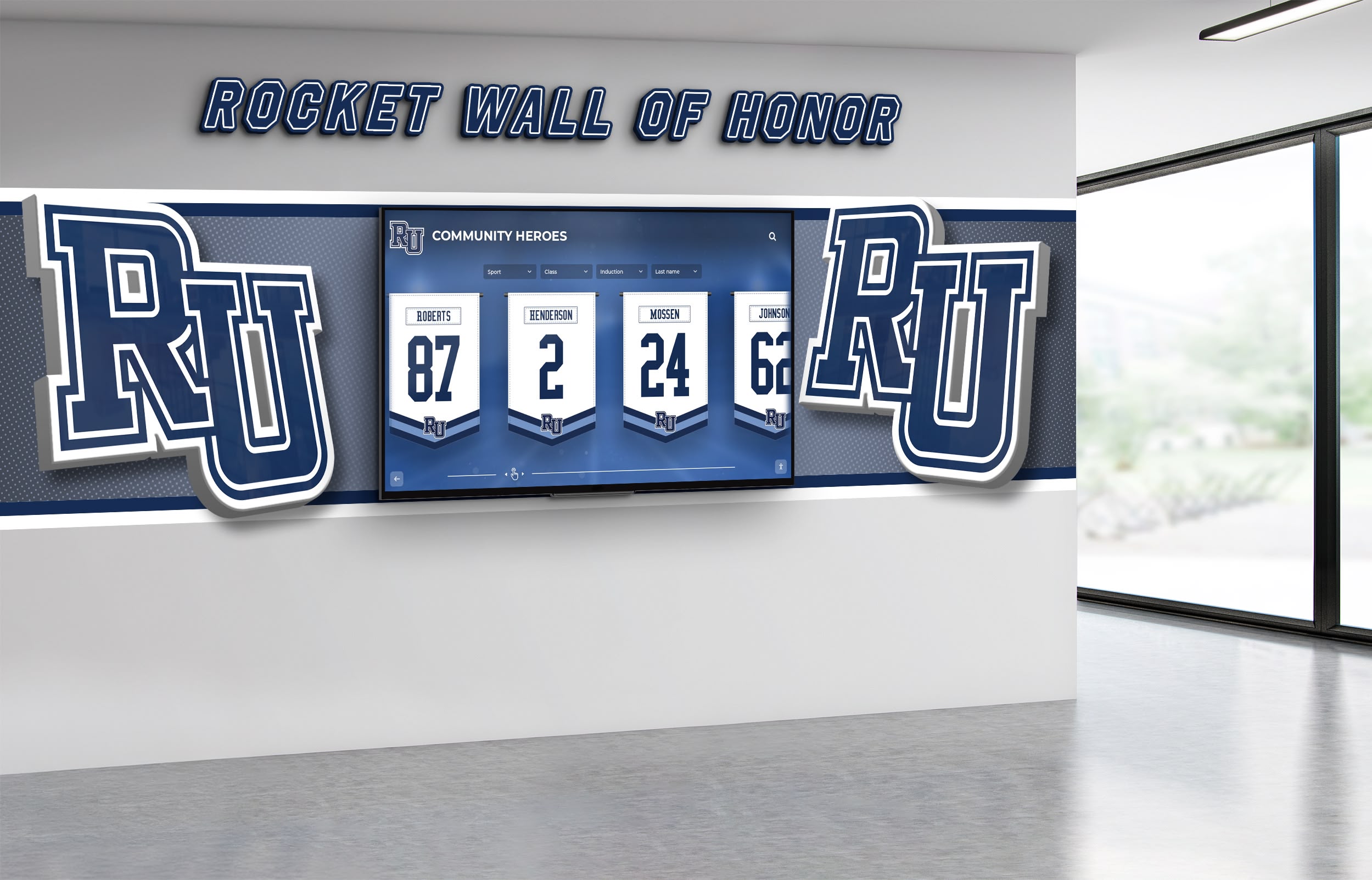
Accessibility and Universal Design Features
Recognition programs should serve all community members regardless of physical abilities, requiring thoughtful attention to accessibility throughout design and implementation.
Height and Reach Considerations: Interactive displays must accommodate users of various heights including children and wheelchair users. ADA guidelines specify maximum reach heights for controls and interactive elements, generally recommending interactive areas within 15"-48" from the floor for side approach or 15"-44" for forward approach.
For recognition displays where mounting higher improves visibility for standing users, consider designs placing interactive elements within accessible reach zones even when displays mount at higher positions.
Visual Accessibility: Support visitors with visual impairments through high-contrast interfaces avoiding reliance on color alone, adjustable text size allowing users to increase font sizes, screen reader compatibility for text-to-speech access, and adequate brightness for visibility in all lighting conditions.
Motor Skill Accommodations: Visitors with limited dexterity or motor control challenges benefit from interfaces designed with accessibility in mind including larger touch targets reducing precision requirements, adequate spacing between interactive elements preventing accidental activation, extended touch duration preventing accidental selections, and alternative navigation approaches beyond touch-only interaction.
Total Cost of Ownership: Budgeting for Display Technology
Understanding complete costs associated with recognition display technology enables realistic budget planning and informed decision-making.
Initial Acquisition Costs
Display Hardware: Commercial interactive displays appropriate for recognition applications typically range from $3,000-$15,000 depending on size, capabilities, and manufacturer. Entry-level 55" interactive displays start around $3,000-$4,000, while premium 75"-86" displays may exceed $10,000-$15,000.
These prices assume commercial-grade interactive flat panels from reputable manufacturers with appropriate specifications for recognition applications. Consumer televisions cost significantly less but lack durability and commercial features necessary for reliable operation.
Computing Equipment: Recognition displays require computing platforms running software and managing content. Computing costs range from $500-$2,000 depending on approach including integrated OPS modules mounting inside displays ($1,200-$2,000), dedicated mini PCs or NUCs ($500-$1,200), and cloud-based thin clients ($300-$600).
Mounting and Installation: Professional installation with appropriate mounting hardware typically costs $1,500-$4,000 depending on installation complexity, mounting approach (wall mount, kiosk enclosure, etc.), and site-specific factors requiring special accommodations.
Custom kiosk enclosures providing freestanding installations with integrated security features cost $2,500-$8,000 beyond display acquisition.
Software and Content Management: Recognition software platform costs vary significantly based on approach including one-time purchase perpetual licenses ($5,000-$20,000), annual subscription cloud platforms ($2,000-$8,000 annually), or custom development ($20,000-$100,000+ for specialized applications).
Purpose-built recognition platforms like Rocket Alumni Solutions offer predictable subscription pricing including software, hosting, updates, and support within single annual costs.
Ongoing Operational Costs
Maintenance and Support: Budget for ongoing costs including extended warranty coverage beyond initial periods ($300-$1,000 annually), technical support for software and hardware issues ($500-$2,000 annually), and routine maintenance including cleaning and minor repairs ($200-$500 annually).
Software Subscriptions and Updates: Cloud-based recognition platforms charge annual subscriptions for software access, hosting, and support. Budget $2,000-$8,000 annually depending on organization size and features required.
Even perpetual software licenses typically require annual maintenance agreements for updates and support, generally 15-20% of original license cost annually.
Content Development and Updates: Ongoing content creation as programs grow requires resources including staff time for profile creation and updates, photography and video production, graphic design and layout, and research identifying new recognitions.
Organizations should budget 10-20 hours monthly for content management and updates once initial implementation completes.
Utility Costs: Commercial displays operating 12-16 hours daily consume electricity adding to operational costs. Typical 65" commercial displays consume 200-400 watts during operation, translating to approximately $50-$150 annually in electricity costs at average commercial rates.
While not substantial, utility costs should be acknowledged in total cost of ownership calculations, particularly for installations with multiple displays.
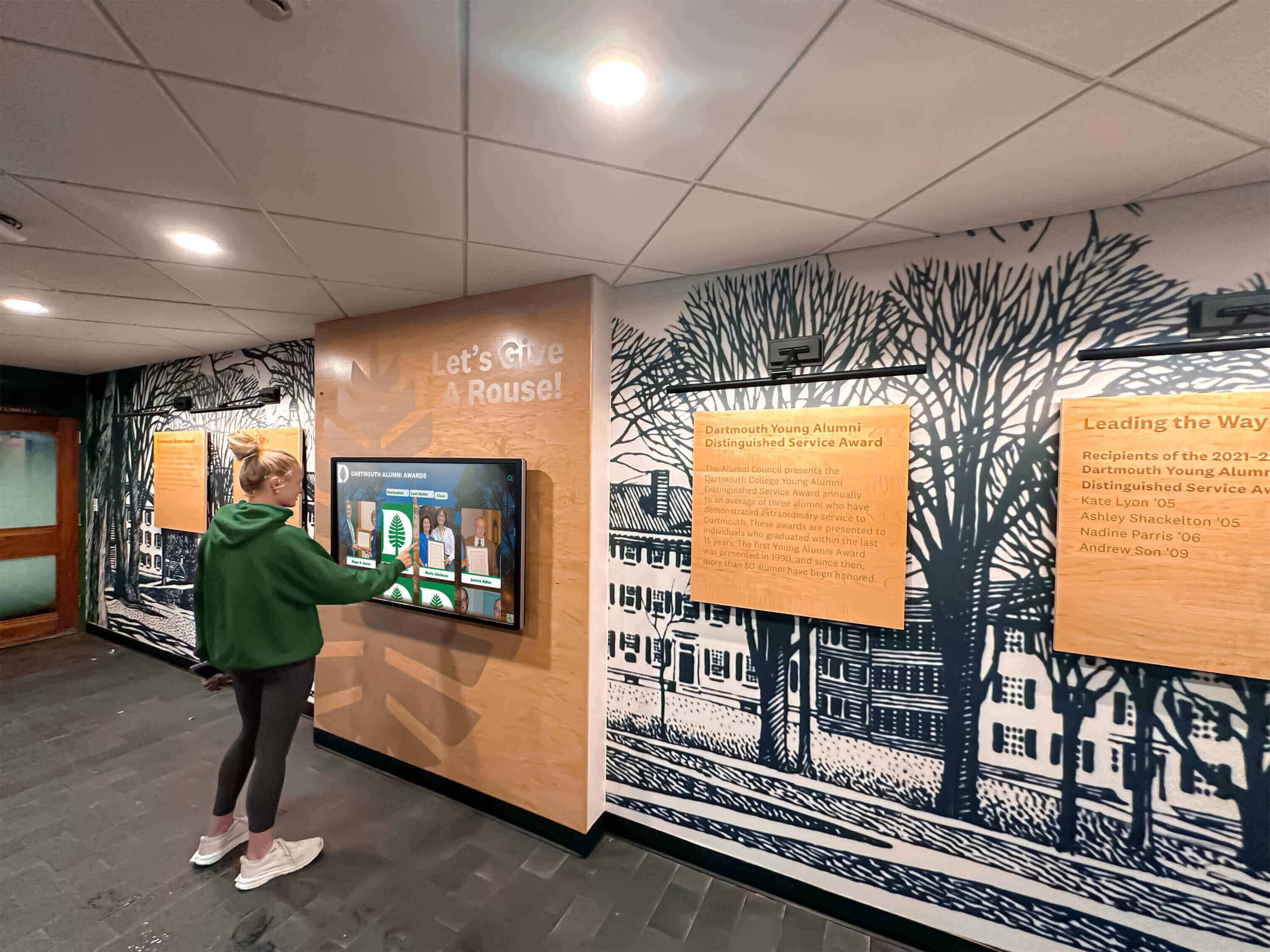
Integration with Comprehensive Recognition Programs
Display hardware represents just one component of effective recognition programs requiring thoughtful integration with content, software, and organizational processes.
Content Strategy for Display-Based Recognition
Displays showcase content—and content quality ultimately determines program impact regardless of hardware excellence.
Profile Development: Effective recognition profiles balance comprehensive information with engaging presentation including biographical narratives telling complete stories, high-quality photographs from relevant periods, achievement summaries highlighting significant accomplishments, personal reflections in individuals’ own words, and contextual information connecting individual achievements to broader history.
Developing compelling content requires substantial investment but ultimately determines whether recognition displays inform and inspire or merely list names and dates.
Multimedia Integration: Modern displays support rich multimedia expanding storytelling beyond text and static images including video interviews with recognized individuals, historical footage documenting achievements, audio narration providing accessibility, and interactive timelines visualizing career or achievement progression.
Multimedia content creates emotionally engaging experiences that static text cannot match, transforming recognition from informational to inspirational.
Regular Content Updates: Recognition programs remain relevant through continuous evolution as organizations identify new recognitions, gather additional information about existing profiles, refresh visual design maintaining contemporary aesthetics, and add features responding to user feedback.
Establish content governance processes defining responsibility for updates, approval workflows, and publication schedules ensuring recognition programs receive ongoing attention rather than stagnating after initial implementation.
Software Platform Selection
Recognition software creates interfaces through which visitors experience content displayed on hardware.
Purpose-Built Recognition Platforms: Specialized platforms designed specifically for halls of fame and recognition applications offer significant advantages including intuitive interfaces optimized for public interaction, proven templates and layouts accelerating implementation, touchscreen-optimized navigation supporting diverse users, and integrated content management for non-technical administrators.
Organizations implementing recognition programs benefit from specialized platforms rather than attempting to adapt general-purpose content management systems for recognition applications.
Custom Development Considerations: Some organizations consider custom software development for recognition applications with unique requirements. Custom development offers complete flexibility but involves significantly higher costs, extended implementation timelines, ongoing maintenance requirements, and potential vendor lock-in if original developers become unavailable.
Unless requirements genuinely cannot be addressed through existing platforms, most organizations achieve better outcomes working with established recognition software providers.
Measuring Success: Recognition Program Effectiveness
Understanding recognition program impact helps organizations demonstrate value and identify improvement opportunities.
Engagement Metrics for Digital Recognition
Modern digital recognition platforms provide detailed analytics revealing how visitors engage with content.
Usage Statistics: Track quantitative engagement including total interactions over time periods, unique visitors versus return visitors, session duration measuring engagement depth, and content views identifying popular profiles or sections.
These metrics reveal whether recognition programs attract meaningful visitor engagement or remain underutilized resources.
Content Performance: Analyze which content generates most engagement including most-viewed profiles, popular search terms, video completion rates, and navigation patterns showing how visitors explore content.
Understanding content performance guides development priorities, focusing resources on content types and topics generating strongest engagement.
Technical Performance: Monitor system reliability ensuring recognition programs function properly including display uptime and operational reliability, software performance and responsiveness, content management system accessibility, and error rates indicating technical issues.
Reliable operation proves essential for effective recognition—programs that frequently malfunction frustrate visitors and undermine recognition missions.
Qualitative Impact Assessment
Beyond quantitative metrics, assess qualitative program impact through methods including visitor feedback surveys or comment collection, recognized individual testimonials, observational studies watching visitors interact, and stakeholder feedback from administrators and sponsors.
Qualitative assessment reveals whether recognition programs achieve intended outcomes—inspiring visitors, honoring recognized individuals appropriately, educating audiences about achievements and history, and fostering community pride and engagement.
Future Trends in Display Technology for Recognition Applications
Display technology continues evolving, creating new opportunities for recognition program enhancement.
Emerging Display Technologies
MicroLED Displays: MicroLED technology promises superior brightness, contrast, and energy efficiency compared to current LCD displays. As manufacturing scales and costs decline, MicroLED may transform large-format display applications through modular panels creating displays of any size, exceptional brightness enabling visibility in extreme lighting, and extended lifespans exceeding current commercial display durability.
Transparent Displays: Transparent display technology enables screens that show content while remaining see-through when displaying darker content. These displays create unique presentation opportunities for recognition applications—profiles appearing to float within glass cases, historical artifacts visible behind biographical displays, and architectural integration preserving sight lines while adding digital content.
Flexible and Curved Displays: Flexible display technology enables curved, rolled, or conforming displays adapting to architectural features. Recognition installations could wrap columns, curve along walls, or integrate into existing structures in ways impossible with flat rectangular displays.
Artificial Intelligence Integration
AI capabilities increasingly enhance recognition applications through automated content summarization, natural language search interfaces, personalized content recommendations, and automated photo enhancement and restoration.
AI-powered features make recognition programs more accessible and engaging while reducing manual content management workload.
Extended Reality Experiences
Augmented reality (AR) capabilities enable recognition displays to direct visitors to physical locations, overlay historical photos onto current views, and create interactive waypoints throughout facilities. Virtual reality (VR) integration could provide immersive experiences exploring historical contexts or achievement moments.
While extended reality remains relatively uncommon in current recognition applications, pioneering programs experiment with these technologies creating next-generation engagement experiences.
Conclusion: Selecting Display Technology That Serves Your Recognition Mission
Display technology forms the foundation of effective digital recognition programs, serving as the interface through which visitors discover stories, explore achievements, and connect with honored individuals. Whether considering ViewSonic displays or alternative commercial display technologies, successful selection requires systematic evaluation balancing display specifications, interactive capabilities, installation requirements, budget constraints, and integration compatibility with chosen recognition software platforms.
ViewSonic manufactures commercial displays and interactive flat panels used across diverse applications including education, corporate collaboration, and public information display. The company’s ViewBoard interactive displays offer multi-touch capability, various size options, and commercial-grade construction suitable for recognition applications when appropriately specified and integrated within comprehensive recognition systems.
However, display hardware represents just one component of effective recognition programs. Complete systems require commercial-grade displays with specifications matching installation environments, specialized recognition software optimizing touchscreen interaction, comprehensive content development telling meaningful stories, professional installation ensuring reliable operation, and ongoing maintenance and content management sustaining program effectiveness.
Organizations implementing recognition programs should evaluate displays in context of complete system requirements rather than focusing exclusively on hardware specifications. The most capable display delivers disappointing results when paired with inadequate software, poor content, or improper installation. Conversely, mid-tier displays integrated thoughtfully within well-designed recognition programs create compelling experiences that honor recognized individuals effectively.
For many organizations, working with specialized recognition technology providers offering complete solutions—hardware, software, installation, and support—simplifies implementation while ensuring all components function together reliably. Solutions like Rocket Alumni Solutions provide turnkey recognition platforms integrating commercial displays with purpose-built software, comprehensive implementation services, and ongoing support enabling organizations to focus on their recognition missions rather than technical complexities.
When evaluating display technology for halls of fame and recognition applications, prioritize solutions that serve your recognition objectives effectively, accommodate your specific installation environments appropriately, fit within realistic budgets for both acquisition and ongoing operation, integrate seamlessly with chosen content management platforms, and deliver reliable performance worthy of the individuals and achievements you’re honoring.
Ready to explore modern display technology for your recognition program? Digital recognition solutions offer powerful capabilities for celebrating achievements, preserving institutional heritage, and creating engaging experiences that inspire visitors while honoring recognized individuals with the dignity and prominence their accomplishments deserve.
